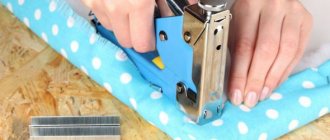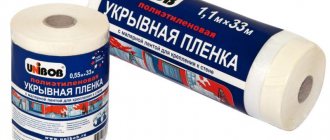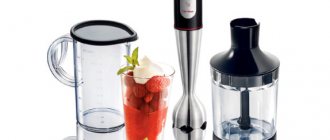Nowadays a blender can be found in almost any kitchen, this device has become so indispensable in everyday life. Gadgets differ in the type of design (there are now two variations on the market, stationary and submersible) and, accordingly, in their capabilities: obviously, grinding coffee beans in a submersible blender will not be as convenient and practical as using the first one. In order to clarify the nuances of using this or that type of blender, it is worth immediately distinguishing between their areas of application.
Stationary blenders
A typical device in this line is distinguished by the fact that it usually has more power than submersible variations, is installed firmly on the surface and thus negates all vibration effects that occur during grinding, is very easy to maintain and cleans in just a minute, and also provides is an ideal option for creating soups and mixtures for various purposes. It is only possible to make minced meat with this type of blender; the submersible one, due to its design, is not intended for solving such problems.
Any stationary blender has three main elements in its design:
- A glass or plastic bowl into which products are loaded;
- A set of metal knives, usually directed in different directions for better chopping and preventing jams during operation;
- An electric motor located at the base of the device.
The models differ from each other in many parameters, for example, the shape of the bowls (there are bottle, classic and cone-shaped), the presence of additional functions (heating, vacuum mixing) and noise level. The last parameter may become critical when choosing if the blender will be used especially often, and some models can outshout a vacuum cleaner.
What is it for?
In the basic configuration, the immersion blender is equipped with only one attachment - a “leg” with knives. The knives are made of steel, which is why their service life is quite long. With such an attachment, the blender is already capable of a lot: chopping food, crushing ice, shredding meat. But usually, blenders come with three attachments, as mentioned above. Consequently, the scope of work is much wider: using a whisk, liquid masses are whipped and even dough is kneaded, and in a special container you can grind coffee, chocolate, and nuts.
An important advantage is the ease of use, lightness and compactness of the equipment. It is easy to transport if, for example, you are going to use it at outdoor events or workshops.
Submersible models
Blenders of this type are an elongated handle, vaguely reminiscent of a bat due to its diameter decreasing closer to the cutting elements, and is usually used for quickly chopping small volumes of soft fruits, vegetables, herbs, or preparing simple creams.
The basic configuration of a typical submersible modification of the device usually includes:
- Handle with cutting elements. It is with its help that the cutting speed, operating mode and other parameters are selected. It also contains a drive, thanks to which the knives begin to chop food;
- Graduated containers made of plastic or glass. Budget devices are usually supplied without it.
It should be noted that not all manufacturers indicate the key feature of submersible models, namely, that they work much better and of higher quality if whipping, chopping or cutting products is carried out with the addition of liquid. It simultaneously cools the cutting edges of the knives and acts as a lubricating agent, increasing both the speed and quality of operation of the device.
Advantages and disadvantages
Due to its design, an immersion blender has both advantages and disadvantages.
Pros:
- It is small in size, so the device can be stored in any kitchen;
- capable of preparing small portions, which is convenient for everyday use;
- can be used in any container;
- due to the addition of different attachments, it has wide functionality;
- The simple design is easy to operate and clean.
Minuses:
- due to its low power, it sometimes does not cope well with grinding solid products;
- It can be difficult to obtain a uniform consistency;
- When working, the device must be held in your hands, which may not be entirely convenient.
Briefly about the additional functions of blenders
The number of additional functions does not always mean that a particular blender can undoubtedly be classified as a premium class; it often happens that budget models are equipped with several operating modes, have a large number of speeds, but in fact it turns out that there is practically no difference between them . Therefore, it makes sense to dwell in a little more detail on the truly useful “skills” of these gadgets.
Vacuum functions: mixing and packing
The feasibility of having a vacuum mixing function in a modern blender is the subject of debate among nutritionists and manufacturers of household appliances: the latter argue that in the process of grinding or mixing, a sufficient amount of nutrients so necessary for the human body deteriorates as a result of an oxidation reaction. To avoid this, after loading the products and closing the lid, the air is completely removed from the bowl by pumping it out of the work area.
What is the point of removing air from the bowl for a couple of minutes while the blender is running is not very clear, because after mixing and grinding is complete, the resulting products will again come into contact with air.
What is really useful is the presence of a vacuum pump in the blender, which looks more like another attachment that helps pack certain products for storage in the refrigerator. The harmfulness of oxidative reactions during long-term storage in modern “No Frost” refrigerators has long been proven, and one of the ways to significantly extend the shelf life of dishes and products is to use the most airtight packaging and containers. The function can also be used when preparing marinade in a blender.
Pulse mode and turbo mode
The purpose of this mode is one - more thorough grinding of solid products and prevention of jamming of working knives. The idea is simple: the nozzles used rotate a little faster than in normal mode, but at the same time they stop for short periods of time, giving the products the opportunity to settle to the bottom of the bowl.
Correct use of the mode has a positive effect on the service life of the knives and the device itself (the engine does not overheat due to grinding for too long, for example, nuts or ice), as well as on the quality of work in general.
Turbo mode is different in that it is activated by the blender only at the end of one or another automatic operating program and represents a short-term increase in speed parameters. It is usually used to achieve softness and tenderness in mixtures, purees and cocktails.
Power, number of speeds and their adjustment
Obviously, to chop different types of food, the knives must rotate at different speeds in order to successfully cope with harder or softer products. It should be understood that devices whose maximum power does not exceed 250-350 W are absolutely not suitable for chopping meat, ice or nuts, and are suitable exclusively for fruits, vegetables and preparing drinks.
As practice shows, stepwise speed control is available on most models whose power is above 500-700 W (while blenders with a motor power parameter above 1,200 W are comparable to food processors). This allows, firstly, to quickly cope with large volumes of products, and secondly, to use the blender on a wider scale.
A useful function can be a smooth adjustment of the operating speed of the device’s knives, which is aimed at manually selecting the optimal operating mode for the blender if automatic programs do not show the best results. For example, if you need to chop potatoes that are too hard, high-speed gear No. 1 is too slow, and No. 2 is too fast, so that the pieces simply do not have time to grind and are constantly in suspension.
Soup maker
Modern expensive models of blenders can be an addition to the same multicookers, if only because of the presence of such options. This function allows the owner not only to use the gadget for its intended purpose, but also for cooking and heating food.
Most devices have a heating operating range that varies between the standard 40°C and 100°C, as well as a maximum operating time in one mode or another, which is usually limited to two hours.
General step-by-step instructions
Instructions on how to properly use a stationary blender:
- Connect the block rack with the motor to the electrical network
- Place food in the mixing bowl without exceeding the maximum mark.
- Attach the filled bowl to the motor unit and be sure to cover it with a lid.
- Turn on the device using the required mode, following the time recommended for continuous operation (it varies for devices from different manufacturers, usually 2-3 minutes)
- After mixing, pour the resulting mixture into a container, and carefully wash the bowl and wipe dry
- Unplug the device from the outlet after use.
Instructions for the immersion blender:
- Attach the required attachment to the blender
- Connect the handle-base with the motor to the electrical network
- Place food in a scratch-resistant container
- Turn on the device using the required mode, following the time recommended for continuous operation (it varies for devices from different manufacturers, usually 2-3 minutes)
- When you are finished mixing or grinding, unplug the appliance.
- Detach the nozzle from the base handle for later washing
If you follow the correct operating mode, your blender will remain an indispensable assistant in the kitchen for a long time and will serve for many years.
Additional attachments
Mid-range and premium models come complete with one or several additional attachments, which are designed to make the device easier to use and more convenient. Information about their availability with a particular device can be found both on the Internet on the manufacturer’s website and on the device box itself.
Dough and puree attachments
Such attachments have one goal: to prepare a particular product with a uniform consistency and without lumps. If the attachment for making purees is, in principle, universal, and manufacturers do not deviate from verified standards in its manufacture, then two types can be supplied for kneading dough:
- A whisk attachment, which is a rounded device for mixing dough in the form of several curved thin metal plates. Due to this, the dough (or cream) is saturated with air, which contributes to its rapid rise and fluffiness;
- The hook attachment is designed for much larger volumes of dough, and it is intended exclusively for high-power devices that are good at handling more than one kilogram of loaded product.
Cutter attachments
This category includes numerous knife attachments of various shapes, which help cut products in a certain shape: cubes, slices, slices (thin plates). This also often includes a classic grater, which looks like a disk, but has pointed holes on the sides. These holes, like those found in the attachments listed above, may differ in size, and therefore some manufacturers include several of the same type, but of different sizes, for the gadget.
Filter attachment
The simplest of all attachments, which is a regular sieve needed to separate the resulting juice from the pulp. After grinding a particular product, the resulting juice flows into a separate bowl, and the processing residues are collected on a filter, from where they can then be easily removed for reuse or disposal.
Baby food
Parents of the 70s, 80s and even 90s of the last century remember very well what it cost them to prepare the first complementary foods for their babies. Vegetables, meat, and soups had to be cooked first, carefully choosing only the best products. And then all this was manually ground through a metal sieve. And all just to treat your child with a teaspoon of puree. They grated apples using a fine grater, damaging their fingers and nails. And in the end, they ate most of the mass themselves (the good stuff shouldn’t go to waste). Some dared to buy ready-made puree, although who knows what was actually put in there. And all because they didn’t know how to use a blender. More precisely, they basically didn’t exist then.
In fact, everything is extremely simple: you need to cook the food, add a little salt, and then grind it in a blender. It will take literally a minute - and the puree is ready, be it meat, vegetable or fruit. By the way, porridge can also be chopped in ready-made form.
Dishes
As has been said many times before, using a blender you can not only grind food, but also actually prepare complete meals. Yes, some of them will require special attachments, but this is a possibility. The following are the simplest dishes that can be easily made at home using a blender, no matter what configuration it has.
Sauces
Making sauces in a blender is one of the easiest and simplest kitchen tasks, and can be used either an immersion blender or a stationary one. The main thing in this case is not so much the choice of operating mode as the correct selection of proportions for a particular sauce.
For example, to make classic mayonnaise, you just need to mix half a glass of vegetable oil, one large or two medium eggs, half a spoon of sugar and salt and lemon juice in a bowl using a blender. Sauces of a more complex composition usually require more ingredients and subsequent boiling over a fire, for example, like the classic garlic sauce for pizza. To prepare it, mix 4 tomatoes, a clove of garlic, a mix of herbs to taste (for example, oregano and basil), several medium-sized peppers and olive oil in a bowl. After all the products have been mixed in the bowl, and the resulting mixture is homogeneous and free of any solid pieces, place it on medium heat for 5-7 minutes.
It should be noted that the simplicity and speed of preparing sauces using a blender is useful to the owner not only from the fact that you do not need to spend so much time cutting and crushing food yourself, but also from the fact that you can regularly pamper yourself with freshly prepared gravy with a new taste and aroma.
Salads and stews
Many agree that a blender is an ideal find for the everyday life of athletes and people leading a healthy lifestyle, because with its help the preparation of both “green” salads, which contain only vegetable vegetables, and classic ones with dressing becomes very fast, since You can quickly change the cutting and grating attachment to the one needed for whipping the sauce, and vice versa.
A “living” example would be a salad of shrimp and cheese, the ingredients for which require alternate use of all available gadget attachments:
- Squid for salad is ground into fine crumbs using an attachment with the smallest piece size;
- Boiled eggs (both whites and yolks) should be passed through a grater with small or medium-sized holes;
- Finally, at the lowest speed, the resulting mass is mixed with mayonnaise, garlic sauce and pieces of cheese.
Stationary devices are more suitable for stews, since they are equipped with attachments with holes of different diameters and shapes, and, for example, making a vegetable mixture will not only be nutritious and healthy, but also look interesting (which is important when feeding small children).
Minced meat for cutlets
Modern powerful models are capable of not only grinding fruits and vegetables, but also confidently handling harder products, such as nuts, ice or even chilled meat. It is clear that only stationary models can cope with such tasks, which are able to withstand the same grinding speed for a relatively long period of time.
However, here there are several nuances that must be taken into account when grinding:
- In any case, the meat should first be cut into pieces, at least roughly, as in the case of working with food processors;
- It is recommended to moisten the pieces with water or milk to make them a little softer. Although blenders are capable of making minced meat from frozen meat products, such a simple step will significantly reduce the grinding time;
- It is important to carefully monitor the operation of the device, since, unlike a meat grinder, it does not have an outlet, and possible processing will lead to the fact that instead of light minced meat, you will get a kind of porridge reminiscent of pate. It is for this reason that speed selection must be done manually, and in this case it is pointless to rely on automatic programs; they are selected for pieces of meat of a certain size and type.
Batter
Using a blender to prepare the dough significantly expands the boundaries of its composition, because in addition to the classic ingredients, you can also use additional ones, for example, apples, rice, cabbage or corn. It is for preparing dough that manufacturers add in addition to the devices various attachments described earlier: whisk attachments are suitable for liquid-type dough, and hook attachments are suitable for thicker and richer ones.
A classic dough recipe for any type of blender could be the following:
- Mix half a glass of milk in a bowl with two broken eggs and a pinch of salt;
- Using a blender, beat the mixture until it reaches a homogeneous consistency;
- Add sugar and baking powder, continuing mixing and gradually adding a glass of flour. At the end, add a spoonful of vegetable oil and stir for another 10-15 seconds.
Dessert dishes, cocktails
Desserts that can be made in a blender are usually either fruit and berry ice cream or smoothies. Both dishes are very simple to prepare; you just need to wash the ingredients first, and then mix them in a bowl until ready. Since blenders are usually purchased for preparing precisely these dishes, modern models have a lot of automatic programs aimed at preparing them quickly.
In addition to the above, it should be noted that the ice cream can be supplemented with chocolate or nut (for example, coconut or almond) crumbs, which can also be done using the device.
Some gadgets are even equipped with special portable bottles, inside of which food can be crushed; you just need to load the fruit inside, select the desired mode, and the device will make a cocktail inside such an improvised bowl. Different operating modes are designed for the owner to choose the consistency of the cocktails: for example, some are puree-like and thicker, while others are liquid.
Pickled products
The previously mentioned vacuum pump function is extremely convenient for marinating pickles and, for example, barbecue meat in half an hour to an hour. If the classic method of preparing a marinade requires it to sit for at least 5 hours, in this case the time is significantly reduced when using any ingredients and any meat, be it pork, poultry or beef.
First, using a blender, all additional ingredients are ground, for example, onions, herbs, sauce and any vegetables, after which the meat is added and this function is used.
Cream soups, puree
Mashed potatoes, along with fruit smoothies, are one of those dishes whose preparation has become much easier with the advent of blenders: devices of any type can confidently handle potatoes, and all that is needed to obtain a soft and tender mass is to choose the right speed and select the right attachment for the job. .
The thickness, fluffiness and tenderness of a dish is usually regulated in two ways: either by adding butter (less often, vegetable) oil, or by adding sauces (garlic or vegetable).
Operating rules
If you want the device to work for a long time and perform its functions efficiently, you need to follow the instructions given in the user manual.
- The device must be assembled correctly and all parts must be secured. Make sure the blade is securely attached to the cup. The jug must be securely installed in the motorized base. An incorrectly assembled blender simply will not work. Sometimes loose parts can fly out and damage the device.
- The device must not be used for mixing non-food products. This may damage it irreversibly.
How to clean the device
After use, fill the carafe with warm water and add a few drops of liquid dishwashing detergent. Turn on the appliance and whisk until the carafe becomes completely foamy. First you need to make sure that the lid is tightly closed. If it comes off, there will be water everywhere! The soap mixture must be drained and the jug rinsed until completely clean.
Lemon helps to remove stains. The jug is filled with water with a few drops of detergent. Then coarsely chopped half a lemon is added. Everything is whipped for one minute. You can use vinegar instead of lemon. The effect will be the same.
To clean stubborn stains, it is better to use a rough sponge, steel wool, or a toothbrush. It all depends on the degree of contamination of the substance.
If the device is very dirty, you need to soak it overnight. To do this, make a mixture of baking soda (0.5 tbsp), vinegar (1 tbsp), detergent (5-10 drops). Pour the mixture into a decanter and leave for several hours. Then pour the contents into the sink and rinse the jug until completely clean. Additionally, you can rinse again with detergent under running water.
Invert the jug and place on a wire rack to dry. It must be allowed to dry completely, otherwise it will create an environment for bacteria to grow.
Cleaning the database
The base cannot be washed! It contains an electronic motor and a device control system. You need to take a sponge or towel, soak it in warm, soapy water and wipe all the places where food or liquid has been spilled. The base must be cleaned immediately after using the device. Avoid allowing food and liquids to dry out.
To clean the control buttons, you need to use cotton swabs. They should be soaked in an alcohol solution. It will dissolve stuck particles and quickly evaporate.
Cleaning the Blades
The removable blades must be unscrewed from the bottom of the jug. Hand wash with hot water and soap. Then scrub with a sponge or toothbrush to remove any hard debris.
Fixed blades can be cleaned in a carafe. To do this, just pour hot water and add a few drops of polydent. It is a whitening and antibacterial agent.
The gasket must be washed, dried and lubricated with olive or vegetable oil.
Grinding with a blender
Coffee beans
The versatility of the blender is the reason why many people want to purchase it; When combined with a multicooker, these two devices can completely reduce the full use of pots to nothing. A blender can quite successfully replace a coffee grinder, successfully grinding beans of any size, but it still requires careful work and adherence to basic rules:
- If you are grinding large grains, it is recommended to regularly stop the operation of the device and shake the bowl so that the pieces do not fall into the space between the knives; if there is a pulse operation function, it should be used;
- Activate only the lowest gear; as practice shows, even small blade strokes per minute are quite enough for high-quality chopping;
- Even if the device confidently works with grains of different sizes, it should still be stopped, since after 5-6 minutes of intensive work the knives will begin to get very hot, and the grains will absorb a metallic smell.
Meat
It is possible to grind meat using an immersion blender, however, even here you should handle the device correctly: in no case should you overload the bowl, since otherwise the knives (and the space around them) will be clogged with fibers and fatty deposits, which will be very problematic to separate.
Despite the fact that the most powerful blenders are now capable of dealing with large pieces, being a full-fledged replacement for a food processor, it is recommended to pre-prepare the meat by cutting it into 2-4 cm cubes - this is the optimal size, suitable for processing both stationary and submersible blender.
By the way, for working with pork and beef (tougher meat products), many manufacturers produce additional attachments:
- Grinding type, which is suitable exclusively for preparing minced meat;
- Shaped, which are useful for quickly slicing meat, for example, for navy-style pasta, soups and other dishes that require more or less solid meat that holds its shape;
- Shredders, which turn pieces of meat into long and thin plates, which are used in preparing, for example, Beef Stroganoff.
Vegetables: onions, tomatoes, etc.
Using a blender to chop vegetables is, in principle, no different from using it to chop meat or other solid foods. The only rule to follow is to never grind vegetables with meat, as they have different hardness and each ingredient requires a different time.
As practice shows, vegetables are quickly chopped in any blender gear, but the selection must again be manual; the use of automatic programs is justified when mixing and preparing any cocktails when working with already chopped ingredients.
Characteristics of equipment
All devices have different technical characteristics. These should be reviewed before purchasing. Ask for a description of the power and a list of basic operations, cleaning tips.
Before purchasing, you need to pay attention to the following factors:
- Motor power (expressed in watts). For most devices it ranges from 100 to 1000 W. A power of 100 to 150 W is sufficient for mixing or mashing. To chop frozen vegetables or fruits you need from 200 to 250 W. For heavy tasks such as crushing ice, you should choose a power of 500 W or more.
- Details. The device includes a cup or jug, a lid, a lid stopper, a base and a tamper.
- Material. It is necessary to take into account the quality of the blades, body, and stand. Mostly plastic or metal is used. But metal is preferable. Plastic is less durable and deteriorates when in contact with heat. Sometimes cups or jugs are made of glass. Mainly for more expensive models.
- Battery life. For continuous operation with an immersion blender, 8 to 12 minutes are enough. Because most mixing tasks take at least two minutes.
- Speed. Plays an important role when mixing food ingredients. In order to grind hard foods such as carrots or radishes in a blender, high speed is required. Softer foods can be mashed at a lower speed.
- Number of functions. Some devices have pre-programmed functions for smoothies, ice crushing, desserts, soups, sauces.
- Price. The more features added, the better the quality of materials and power, the higher the cost. At the top end of the value range are multifunctional blenders that have an industrial design. For a professional chef, such a device will replace many others and can be a profitable investment.
Using a blender for whipping
As soon as whisk attachments appeared in the set with blenders, the question of the advisability of purchasing a mixer became very relevant, given that the latter has only one use. What speaks in favor of the blender in this case is that:
- The mixer is not able to work with solid pieces of food, for example, if you need to whip up a cocktail, adding strawberries at the same time, then this can only be done using a blender;
- The knives are capable of speeds of up to 20,000 revolutions per second, while the mixer attachments are capable of speeds of up to 10,000;
- The mixer is capable of producing a mixture of only one consistency, while the blender can be programmed for mousse, puree, cream or cocktail.
Beating egg whites, creams or smoothies with a submersible blender usually turns out to be much faster than with a mixer of the same class (not to mention a stationary model), so the use of this device is completely justified: it is simply more multifunctional and has more advantages than a mixer.
Useful video
The video contains interesting recipes for a blender:
Have you got a blender? What can you do and cook with this device? A blender is a popular representative of kitchen appliances, which is designed for chopping or mixing products. This device is widely used among cocktail lovers, as well as among parents of small children, as it makes it possible to quickly prepare any puree for the baby at home.
Is it possible to beat meringue with a blender or prepare cream soup? We suggest finding out what types of representatives of this device there are and what dishes they will help you prepare.
Precautionary measures
When using any household appliances, and a blender in particular, you must be extremely careful and carefully follow all operating instructions, since there is a possibility of injury and other damage. This is especially important for those devices that constantly interact with food. And in a blender it can be wet and sometimes greasy. To ensure that the blender brings only benefits and does not harm you, manufacturers have specially drawn up rules for its proper use. They must be included with the device. But if you have lost them or you don’t want to plunge into the world of boring technical language, then we will tell you everything here.
If you have an immersion blender, then under no circumstances immerse it in food more than halfway up the stem. Be careful that splashes or pieces of processed food do not get into the unit’s motor.
Be sure to unplug the device from the outlet as soon as you finish using it. Remove the nozzle and rinse under running water. You can wash the immersion blender and, in particular, the attachment, using a mild detergent. Then dry each part thoroughly.
Never connect wet parts to the handle of the device. This way you will permanently damage the device.
If you need to clean the handle where the motor is located, do it with a damp cloth. Just gently wipe the part with it. And make sure that moisture does not get on the motor. Otherwise, your device will stop working and you will just have to throw it away.
And a little childish advice: do not stick your fingers in to remove a stuck piece from under the knife while the device is on.
If you have a stationary model, to wash it, pour cool water into the bowl and start the device. In a few seconds everything will be cleaned, and you just need to pour out the dirty water. After this, the bowl should be rinsed a little more and dried completely.
Do not wash the stand under any circumstances; this is dangerous for you and your device. All you can do if it gets dirty is gently wipe it with a damp cloth. But before doing this, be sure to unplug the device from the outlet.
Use the device according to the power it is capable of. That is, don't try to squeeze more out of it, you'll just overload it. Be sure to let him rest and cool down. This is especially true when you are grinding hard products. Some models are equipped with a special auto-shutdown, which is triggered if the unit overheats.
Despite the fact that a blender is a chopper, put only chopped products into it, remove seeds and stalks from them.
Do not try to chop greens with a stationary unit. It's just not designed for this type of work. These devices must be loaded at least halfway so that they function normally and are not overloaded.
Pay attention to what material the body is made of. If it is plastic, then be very careful with it. Excessive load and falls can ruin it. But if the body is metal, then it cannot be cleaned with powder and hard sponges. Otherwise, scratches will appear.











